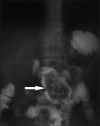Pathophysiological and clinical aspects of the diagnosis and treatment of bezoars
- PMID: 31040619
- PMCID: PMC6479654
- DOI: 10.20524/aog.2019.0370
Pathophysiological and clinical aspects of the diagnosis and treatment of bezoars
Abstract
Bezoars are intraluminal conglomerates of indigestible foreign materials that accumulate in the gastrointestinal (GI) tract. They consist of vegetable or fruit fibers, hairs or other substances; accordingly, bezoars are classified as phytobezoars, trichobezoars, pharmacobezoars, etc. Although sometimes asymptomatic, bezoars may cause serious symptoms, such as abdominal discomfort or pain, dysphagia, hematemesis, or even life-threatening entities (GI bleeding, obstruction or perforation). Current technological applications have contributed to the diagnostic and therapeutic approach to these masses, mainly through endoscopic techniques able to diagnose, fragment and extract bezoars, as well as laparoscopic and other surgical modalities that may be used to treat serious complications. Although bezoars were described centuries ago and the term was officially introduced in the mid nineties by Quain, they are still a demanding pathological entity. Their pathophysiology, accurate and prompt diagnosis, as well as successful and minimally invasive treatment, remain under investigation and see continuous progress. Current advances in these challenging areas are discussed in this review, which attempts to present an in-depth study of bezoars along with the well-established modalities and techniques.
Keywords: Bezoar; endoscopy; ileus; intestinal obstruction; phytobezoar.
Conflict of interest statement
Conflict of Interest: None
Figures







References
-
- Koulas SG, Zikos N, Charalampous C, Christodoulou K, Sakkas L, Katsamakis N. Management of gastrointestinal bezoars:an analysis of 23 cases. Int Surg. 2008;93:95–98. - PubMed
Publication types
LinkOut - more resources
Full Text Sources
